Fukasaku and Scorsese: Yakuzas and Gangsters
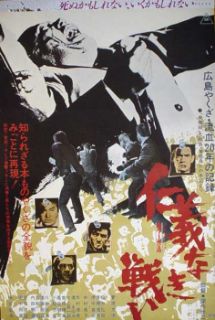 JINGI NAKI TATAKAI JINGI NAKI TATAKAI
(Kinji Fukasaku)
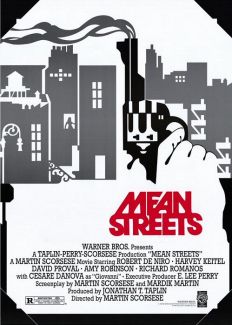 MEAN STREETS MEAN STREETS
(Martin Scorsese)
|
As Mark Schilling points out yakuza and Hollywood gangster films have long constituted distinct film genres. Likewise both genres have evolved over the years (1). Paul Schrader argues that the yakuza films bears little resemblance to its American or European counterparts. He carries on saying that the yakuza film does not reflect the dilemma of social mobility seen in the Thirties gangster films, nor does reflect the despair of the post-war film noir since it aims for a higher purpose, a moral purpose that springs from the giri-ninjo (giri, social obligation; ninjo, personal inclination) conflict, an essential theme in yakuza films (2).
From a historical point of view both the Japanese and Hollywood gangster films have evolved at different times and with different themes. At first sight this can be seen in two gangster films released in 1973 : one Japanese (Jingi Naki Tatakai or Battles Without Honour and Humanity by Kinji Fukasaku) the other American (Mean Streets by Martin Scorsese) which emerged from very different cinema history backgrounds but which made use of some identical themes and film techniques to arrive at similar conclusions. These two films also marked an important transition in the way that gangster and yakuza films will be conceived in the future. This essay will not only try to examine these similarities and differences between these two films but how themes initially belonging to one or the other have been taken up by their respective counterparts.
The Depression and the coming of sound marked the beginning of a new kind of realism in Hollywood films. From here a new genre evolved that served to challenge the idea of the American dream, economic expectations and the possibility of social equality. The gangster film became, at the beginning of the 1930s, a reflection of society. The gangster became a tragic hero that rise to power through crime as the only alternative to succeed. The Production Code forced producers to shift the emphasis from the gangster as a tragic hero to the gangster as a social victim, emphasizing in the ending of films that crime does not pay.
The figure of the gangster changed radically in the 1940s and 1950s. The heroes in these films were now private or police detectives, but in any case enforcers of the law. Gangsters, even though in prominent roles, are always the baddies of the films. Not until 1967 with Arthur Penn's Bonnie and Clyde, a film that again is set during the American Depression, gangsters will be represented not just as tragic heroes but revolutionary ones too. The release of Coppola's The Godfather in 1972 helped even more to mythologize the figure of the gangster, in this case the Italian Mafia.
|
Even though the film critic Keiko McDonald cites earlier examples of yakuza films such as Daisuke Ito's Chuji tabi nikki (Chuji's Travel Diary, 1927) or Hiroshi Inagaki's Mabuta no haha (The Mother He Never Knew, 1931) the heyday of yakuza films really started at the beginning of the 1960s in the form of the ninkyo eiga (chivalrous film), being its pioneer Tadashima Tadashi's Jinsei gekijo: Hishakaku (Theatre of Life: Hishakaku, 1963).
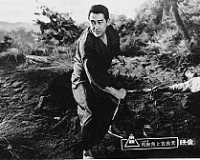 JINSEI GEKIJO: HISHASAKU
JINSEI GEKIJO: HISHASAKU
(Tadashi Sawashima)
|
This film established a new yakuza narrative formula that would be used in one variation or another in over three hundred films before the decade was out. It also furthered the cause of a revived star system (3). The setting is now late Taisho to early Showa (1923-40) and like the Hollywood gangster film the story takes place in an urban setting such as Tokyo. Good yakuza are seen living up to the jingi code and dying by it. Jingi is the moral and ethical code of honour for the yakuza. As McDonald explains: "the yakuza expericences his own version of the characteristic Japanese tension between opposing values of giri and ninjo" (4). "Jin expresses the Confucian virtue of benevolence; gi, the values of justice and rectitude...the element of rectitude yields the concept of absolute loyalty to the Organization, its boss (oyabun) especially" (5). Their goodness is underlined by always wearing japanese traditional clothes. |
In fact, Gregory Barrett argues that the yakuza film combines elements of the samurai film and the yakuza code of jingi can be seen as a modern version of the bushido code of the samurai(6).
The bad yakuza are only interested in money and represent the modernization and Westernization, with its subsequent corruption of traditional japanese social values of engagement, of Japan. Good and bad must fight it out in a kind of moral territorial war.
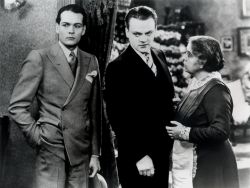 THE PUBLIC ENEMY
THE PUBLIC ENEMY
(William Wellman)
|
So whereas Scorsese's Mean Street is a homage to gangster films of the thirties like The Public Enemy or Little Caesar with an added new realism and innovative film techniques such as hand-held camera, colour saturation, jump-cuts and slow-motion, Fukasaku's Battles Without Honour and Humanity is a rejection of the idealized depiction of the yakuza in the ninkyo eiga. I have not found any material written in English that could connect both films. Since they were both released the same year it is hardly possible that they have influenced each other in any way.
According to Schrader the enormous success of The Godfather in Japan made Toei to finance more "documentary style" yakuza films or jitsuroku eiga (true story films)(7).
This seems to be a bit contradictory since The Godfather is far from being a documentary style gangster film, especially in its opening scenes, due to its stylish cinematography of very dark tones in interior shots, a reflection on the machinations of the Mafia, in contrast with the very bright light used in outdoor shots during the wedding of Don Corleone's (Marlon Brando) daughther.
|
Furthermore, The Godfather appears to be closer to the yakuza films of the sixties with its stress on family loyalty, honour and justice. Schrader, quoting Tadao Sato, explains how duty can be more important than humanity in the ninkyo eiga of the sixties (8). This can also be applied to The Godfather when, for example, Michael Corleone (Al Pacino), now the new godfather after his father's death, orders to kill his brother in law Carlo, without considering his sister's suffering, out of duty to revenge the killing of his elder brother Sonny (James Caan) in which Carlo is believed to have been involved. He even lies to his wife when he is asked if he took part in the murder of Carlo. Much closer to these so-called "documentary style" yakuza films is Scorsese's Mean Streets.
It is quite interesting to point out that in an interview with Kinji Fukasaku, he explains how he felt his seventies films where seen by society as too brutal, that he felt rejected by mass audiences (9). Later on, his innovations in terms of techniques and depiction of violence will become mainstream. In the same way, if Scorsese's Mean Streets brought freshness to the gangster film genre with his realistic and unglamorous view of the persona and way of living of small time gangsters in Little Italy, in Goodfellas (1990), he will give them a mythical quality. Mean Streets, in some ways, also share the giri-ninjo conflict that prevails in the yakuza film. The giri takes the shape of Charlie (Harvey Keitel) trying to remain loyal to his uncle Giovanni against the ninjo, his profound Catholic background that tells him to help Johnny Boy (Robert de Niro) and his love for his cousin Teresa. The plot develops as follows:
Oscar, owner of a restaurant, cannot make a payment to Giovanni, Charlie's uncle. This restaurant will become Charlie's, but Giovanni disapproves of his involvement with Johnny Boy (Robert de Niro) and thinks of Teresa, Johnny Boy's cousin and Charlie's secret girlfriend, as being crazy, she is in fact epileptic. If Charlie wants the restaurant, and secure his future, he has to stop intervening in the dispute between Johnny Boy and Michael (Johnny Boy owes money to Michael). His religious convictions are confronted with the economic matters of real life. To make things worse for Charlie, Teresa asks him to move to a flat and live together.
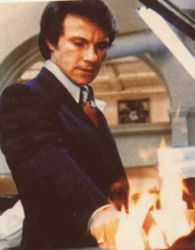 "Charlie"
"Charlie"
(Harvey Keitel)
|
Thomas Schatz almost appears to perfectly describe, in his Hollywood Genres, Charlie's internal conflict when he talks about the downfall of the gangster hero: "This internal conflict- between individual accomplishment and the common good, between man's self-serving and communal instincts, between his savagery and his rational morality- is mirrored in society, but the opposing impulses have reached a delicate and viable balance within the modern city. The gangster's efforts to realign that balance to suit his own particular needs are therefore destined to failure" (10). David Desser, when he discusses about the giri-ninjo conflict in the post-war samurai film, explains how "in Japanese life the giri/ninjo conflict is unresolvable" and as consequence "when confronted by the giri/ninjo conflict, the heroe of the Nostalgic Samurai Drama makes his choice knowing full well the price to be paid in social alienation and/or self-abnegation" (11). In Charlie's case there are several conflicting things that threaten to destroy him. First of all, it is his loyalty to uncle Giovanni, seen as the authority figure of the neighborhood (the oyabun figure in the yakuza film), somebody who oversees that everything is kept in order in the community. Secondly, it is Charlie's almost attitude of penance which materializes in the shape of Johnny Boy.
|
This is exactly what the voice-over tells Charlie when Johnny Boy makes his first appearance at Tony's bar, Charlie's friend. Another reason why Charlie has to help Johnny Boy is because they are part of the family.
The family, either blood or the gangster-family is, to put in a way, the soft spot of the hero in the gangster film, a family that, ironically, will ensure the hero's destruction (12). His rigid religious convictions are against all he does (work, collecting payments for his uncle Giovanni) and feels (his crush for the black dancer at Tony's bar which also represents social pressure from his own white-Italian racist background), creating a sense of permanent guilt and a strong desire to be punished. Charlie is in a constant struggle to achieve his goals but he fails. As Schatz points out, the main flaw in the gangster hero is " his inability to channel his considerable energies in a viable direction" (13). As the voice-over tells Charlie right at the beginning of Mean Streets: "you don't make out for your sins in the church, you do it in the streets, you do it at home...". Charlie spends all his energy to do just that, he has set out as his penance to save Johnny Boy and at the same time keeping his uncle happy, but this might not be a viable direction in the real world.
On the other hand Fukasaku seems to take the themes and purposes of the earlier Hollywood gangster films of the 1930s when as McDonald explains he "puts its subject in a broad social context: modern Japan in the twenty-five year period ending in 1970" (14). Fukasaku's films question the values of post-war Japan by linking the ascension of the Yamamori gang in Battles Without Honour and Humanity with that of Japan itself. This also mirrors the rise to power of for example James Cagney in The Public Enemy. The conversion of the yakuza into businessmen can also be seen in the situation that Lee Marvin encounters after spending some time in prison in John Boorman's Point Blank(1967) or Burt Lancaster's character Frankie Madison in Byron Haskin's I Walk Alone (1948).
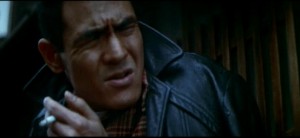 "Shozo Hirono"
"Shozo Hirono"
(Bunta Sugawara)
|
Shozo Hirono (Bunta Sugawara), main character in Battles Without Honour and Humanity, is a brute that stills believes and follows the jingi code of the yakuza. So, when Hirono gets involved in a fight with a member of a rival gang he decides to follow the ritual of cutting his little finger (yubitsume) and presents it wrapped in a white cloth to the rival gang's oyabun to appease the wrath of his boss. Yamamori, in fact, makes fun of him saying that the cutting of a finger will not cost him anything and he (Hirono) had better do some job to get money for the clan. |
Hirono, even though faithful to the jingi code, has no idea of have to perform the rite of yubitsume. Fukasaku gives the sequence a comical tone to scorn the yakuza ceremonial that permeates the ninkyo eiga. The fact that the significance of this important ritual is not taking seriously is highlighted when, as Hirono is offering his finger to the rival oyabun, this one says that there was no need to go to such extremes for such a silly fight. Later on, Hirono will kill another rival oyabun to save his own boss and agrees to go to jail when Yamamori offers him the running of the gang when he is released. Once again, Hirono, sticking to the code of jingi, is used and betrayed by his own boss.

These two examples serve to reflect the condition of both Charlie and Hirono as anachronic figures. Their codes are useless in the modern world. So it could be said that Scorsese's Mean Streets has much in common with the classical yakuza films or ninkyo eiga and that Fukasaku takes upon the social and historical issues that are normally seen in the classical gangster film.
It also quite interesting the fact that Mean Streets, a independent production, notwithsanding what we have said earlier, is much closer in content rather than style to the conventions of the gangster film genre of the Old Hollywood. On the other hand, Battles without Honour and Humanity, a Toei studio production, appears to be a more challenging film in terms of genre conventions. Furthermore as Fukasaku himself has commented his "contribution to the development of Japanese cinema was to abolish the star system" (15). In short, to abolish the star vehicle film where audiences could expect the sort of film they were going to see according to the actors that star in them. This remark would place the figure of Fukasaku close to the environment in which Mean Streets was born: the New Hollywood cinema where the director took a more prominent role in detriment of the actors.Nevertheless, Fukasaku was, for the most part of his career, a studio director working for Toei in any kind of films, many of them quite conventional.
During the so-called New Hollywood period of the end of the 60s and beginning of the 70s directors were in full control of their work, influenced by the image of the director as creator of the European Art Cinema of the 50s and 60s. Certainly the work of the French New Wave had an enormous influence on the New Hollywood films, especially the technical innovations that the former brought into filmmaking. Lightweight camera equipment and more sensitive film stock could be used in location shots with only the available light, given the films a sense of cinéma vérité. Other techniques used were jagged editing and jump-cutting for both theoretical and material reasons. I am not quite sure how much the French New Wave influenced the work of Fukasaku. Japan had its own New Wave with Nagisa Oshima leading its way. Oshima, rather that acknowledging any influence from his French counterparts, cites the works of Yasuzo Masumura and Ko Nakahira as having an enormous impact on his own films (16 ).
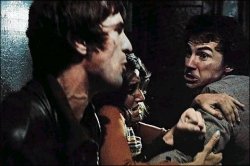
As mentioned earlier, Mean Streets and Battles Without Honour and Humanity were made under the influence of very different film cultural contexts: The Classical Hollywood and European Art Cinema and the ninkyo eiga respectively. On the other hand, both filmmakers had been influenced by documentary films. Scorsese "witnessed American daily life etched for the first time on American screens in unsanitized, ethnically diverse images by the New American Cinema documentarists" (17). Fukasaku's use of the hand-held camera started after viewing newsreels from the student movements, such as the students and the farmers fighting the police (18). One can assume that he meant the documentary films that Shinsuke Ogawa made between 1968 and 1973 focusing on the protests of rural villagers and farmers around Sanrizuka against the construction of Narita International Airport (Summer in Narita, The Three-Day War in Narita, Peasants of the Second Fortress, The Building of the Iwayama Tower and Heta Village).
Fukasaku believes he first began to use hand-held camera in Hitokiri yota (1972). In fact it is in an previous film made earlier that year, Gunki Hatameku Moto ni, when he also uses such technique and photographic stills taken in the New Guinea front during the Second World War. The film follows the widow (Sachiko Hidari) of sergeant Togashi (Tetsuro Tanba) in her search to know what really happened to her husband, executed for desertion in New Guinea. Whereas the main story is shot in colour, flashbacks of the interviews she made to her husband's comrades are shot in black and white to give them a documentary feeling.
So, even if Scorsese and Fukasaku had very different cinematic backgrounds, they both arrived at similar views by making use of similar film techniques: their depiction of violence and demystification of the image of the gangster and his world and, specially, the use of documentary style techniques to create a greater sense of realism and immediacy to the people portrayed in their films.
These similarities between both films are more revealing in their first minutes. In the first two minutes of Mean Streets we see Charlie being woken up by a disorientating voice-over. I said disorientating since it is not Charlie's own voice (it is fact Martin Scorsese's own voice). The voice-over emphasises, along with what the mise-en-scene reveals (an austere room and a spotlighted crucifix on the wall), Charlie's struggle between his religious convictions and his rough environment and unlawful activities and friends, all this with the city as backdrop. The handheld camerawork follows the tormented Charlie around the room. Jump-cuts, punctuated by the first notes of "Be My Baby" by The Ronette's, are used after Charlie returns to the bed and falls sleep again. This sequence is followed by the title credits, accompanied by the same song on the soundtrack, which consist of a home movie footage of the christening of a little boy from Charlie's family and the subsequent party where the main characters of the film are seen.
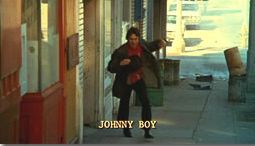 "Johnny Boy"
"Johnny Boy"
(Robert de Niro)
|
The use of home movie footage creates a sense of realism in the film. The characters are seen participating in the rituals of life. Once the title credits end there is a long shot of a religious procession in Little Italy. The shaky and black and white 8 mm home movie footage is transformed into the normal colour 35 mm film of the movie itself that perfectly situates the story in a specific spatial context. From this point on what if follows it is a rather long introduction of the four main characters of the story which also gives some clues about each character's personalities. Charlie is the religiously repressed and guilty one, Tony runs a bar and also has a strong sense of morality, Michael is the racketeer, easily fooled, and Johnny Boy is the crazy one. Each character's introduction ends with a freeze-frame and the superimposition of their names on the screen. |
The use of these techniques recalls the beginning of Battles Without Honour and Humanity. This starts with a still photograph of the mushroom cloud covering the sky of Hiroshima accompanied by the dramatic soundtrack of Toshiaki Tsushima. This photograph is followed by several others of the city right after the bombing and newspaper news. Then the narrative shifts to moving images, still in black and white, of a Hiroshima public market that changes into the colour and anamorphic picture of the film itself. Then, during the attempt rape of a Japanese girl by American G.I. and the scuffles that follow are shot by Fukasaku with a shaky hand-held camera. The images come to an abrupt stop every time the main characters are introduced, one by one, in freeze-frames with their names superimposed on the screen.
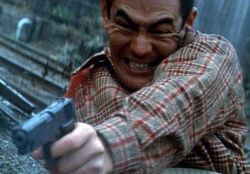
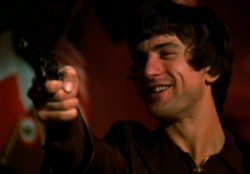
|
It is quite obvious that the beginnings of both films are far from being identical but it also quite true that similar techniques are employed to achieve similar purposes. The home-movie footage of Mean Streets and the stills and initial shot in black and white of the Hiroshima market in Battles Without Honour and Humanity give the material a sense of authenticity and realism as well as placing the narrative in a very specific historical, cultural and spatial context. The freeze-frame and titles superimposition underline the influence that documentary or cine'ma ve'rite' had on both directors. Furthermore, these techniques and their respective plots work to demystify the yakuza and gangster film genre. Here it seems appropriate to quote once again Mark Schilling when he explains how "In the late 60s, directors such as Kinji Fukasaku, Kosaku Yamashita and Junya Sato began making yakuza movies that more nearly reflected contemporary realities, with a gritty violence and brutality that had little to do with the ideals of giri and ninjo, everything to do with life and death on Japan's mean streets" (19).
Another point that unites Mean Streets and Battles Without Honour and Humanity is their autobiographical quality. This is more prominent in Scorsese's film. Some of the characters in this film are based on friends of the director and events that happened to him. As Scorsese himself has explained "Mean Streets was an attempt to put myself and my old friends on the screen, to show how we lived, what life was in Little Italy. It was really an anthropological or a sociological tract"(20). |
The autobiographical elements are less obvious in the Fukasaku's film. Still, Battles Without Honour and Humanity are based on real events. The story is based on a novel by journalist Koichi Iiboshi from the interviews he made to the imprisoned former boss of the Mino gang, Kozo Mino (21). Nevertheless, Fukasaku explains how in making a new sort of yakuza films, youthful and violent, as he has recently done with his final complete film before his death Battle Royale, he "wanted to replace the old techniques with a new kind of film, where I could overlay my own experiences of living in post-war Japan" (22). The end of the war meant to the young Fukasaku the total collapse of all the values he had learnt at school: authority, nation, honour, etc. (23). Fukasaku views the end of the war as the beginning of a state of anarchy where friendship and camaraderie are put to the test, a view that becomes the main motif in Battle Royale. This theme also constitutes one of the main elements in Mean Streets as Charlie tries to help his closest friend Johnny Boy against a menacing environment that always threaten to destroy their friendship.
The connections between Mean Streets and Battles without Honour and Humanity do not end in what they achieved in terms of subversion and breaking of genre conventions and innovative visual elements. These films have influenced enormously the development of the yakuza and gangster films made later on. An influence that it is still felt today. So it does not come as a surprise that Battles Without Honour and Humanity was selected by the prestigious Japanese cinema magazine Kinema Jumpo among the twenty best films of the history of Japanese cinema. On the other hand Mean Streets is often described, along with The Godfather as "the two most important gangster films of the seventies" (24).
The narrative and stylistic innovations of Fukasaku's film were soon exploited by its own production company, Toei, in making more jitsuroku eiga. To add more realism to these new yakuza films, former gangsters such as Noburo Ando were cast in roles. Ando had a small part in Battles Without Honour and Humanity and starred in several films such as Boriyoku Gai (The Violent Street, 1974) and Ando Noboru no Waga Tobo to Sex no Kiroku (Noboru Ando's Chronicle of Fugitive Days and Sex, 1976). Later he directed his own films: Yakuza Zankoku Hiroku- Kataude Setsudan (Yakuza Cruel Secrets- Arm Dismemberment, 1976). The decline in popularity of yakuza films started to be felt in the box office in the mid-1970s.
Nevertheless in the 1990s independent directors such as Ishii Takashi, Kitano Takeshi, and more recently Miike Takashi, have tried to redefine the genre. The graphic violence depicted in their films recalls Fukasaku's own view of the savage world of the yakuza. Aaron Gerow sees Kinji Fukasaku as the precursor of Miike Takashi in his "apocalyptic nihilism and sympathy for Japan's social marginals" (25). These characteristics are also shared by Ishii Takashi's film Gonin (1995), where the five main characters of the story represent five sort of outcast in the structure of Japanese society: A former pop-singer and secret gay, a former policeman who has just being released from prison, a recently sacked salaryman, a brainless former boxer and now pimp who goes out with a Filipino illegal immigrant and a gay blackmailer.
Gonin has been compared to Pulp Fiction (1994) by Quentin Tarantino, a director that owes something to Mean Streets. Quentin Tarantino, just like his Japanese counterparts, has tried to redefine the gangster film in his 90s films. Narrative and visual virtuosity but specially the extensive use of a soundtrack of popular songs are some of the main elements of Tarantino's work. One of achievements of Scorsese's Mean Streets is his choice of soundtrack, mainly rock, soul and pop songs he grew up with and its importance in providing images for the film. As Scorsese has mentioned "the whole movie was 'Jumping Jack Flash' and 'Be my baby'" (26). The same can be said of the later director, Guy Ritchie, who has helped to create a sort of London's East End gangster film boom by the end of the 90s. One of the most obvious devices lifted from Mean Street in Richie's first feature film Lock, Stock and Two Smoking Barrels is the use of the snorry-cam (a camera that it is fixed to the actor's body. In Mean Streets it was to used to show Harvey Keitel's drunkenness as he staggers around Tony's Bar) after one of the protagonists, Eddy (Nick Moran), had lost 100,000 pounds on a bad poker hand. In his second film Snatch, Ritchie, displays an ingenious and complicated narrative structure of several interlocking stories as well as a flashy camerawork, all accompanied by an almost continuos soundtrack of popular tunes.
So we can argue that Battles without Honour and Humanity and Mean Streets share many similarities that goes further than simply film techniques or narrative innovations. Their release on the same year signified a break in the way that yakuza and gangster films were made afterwards. Their importance in the history and development of this film genre in particular is reflected on how much Fukasaku and Scorsese's works have influenced a new generation of filmmakers that have been trying to reshape the gangster film genre since the 90s. Also both films adopted themes that were seen as conventions belonging to the other's film genre.
Notes
- Schilling, Mark Yakuza Films: Fading Celluloid
Heroes (Japan Quarterly, July-September 1996, vol. 43, 6), p. 30.
- Schrader, Paul Yakuza-Eiga: A Primer (Film
Comment, 1974 vol. 10, 1), p. 10.
- Nolleti, Arthur and Desser David Reframing
Japanese Cinema: Authorship, Genre, History (Indiana University Press, 1992), p. 174.
- Ibid, p167.
- Ibid, p190.
- Barrett, Gregory Archetypes in Japanese Film
(London: Associated University Presses, 1989), p.64.
- Schrader, Paul, p.10.
- Ibid, p12.
- Macias, Patrick TokyoScope:The Japanese Cult
Film Companion (San Francisco: Cadence Books, 2001), p. 154.
- Schatz, Thomas Hollywood Genres (Boston:
MacGraw-Hill, 1981), p.85.
- Nolleti, Arthur, p.150
- Ibid, p.94.
- Ibid, p.94.
- Nolleti, Arthur, p. 184.
- Macias, Patrick, p. 185.
- Desser, David Eros plus Massacre: An
Introduction to the Japanese New Wave Cinema, (Indiana University Press,1988), p. 41-43.
- Thompson, David and Christie, Ian Scorsese on
Scorsese, (London: Faber and Faber, 1989),p. xx.
- Macias, Patrick, p. 154.
- Schilling, Mark, p.40
- Thompson, David and Christie, p.48.
- Macias, Patrick, p. 141.
- Ibid, p.153.
- Gerow, Aaron, Fukasaku Kinji: Underworld
Historiographer.
- Hardy Phil, Gangsters (London: Aurum Press,
1998).
- Gerow, Aaron.
- Thompson, David and Christie, Ian, p. 45
Bibliography
Barrett, Gregory (1989) Archetypes in Japanese Film, Associated University Presses, London.
Bordwell, David and Thompson, Kristin (1994) Film History: An Introduction, McGraw-Hill, London.
Cook, David A. (1996) A History of Narrative Film, WW Norton & Company, London.
Desser, David Towards Structural Analysis of the Postwar Samurai Film in Nolleti, Arthur and Desser David, Reframing Japanese
Cinema: Authorship, Genre, History (1992) Indiana University Press.
Desser, David (1988) Eros plus Massacre: An Introduction to the Japanese New Wave Cinema, Indiana University Press.
Gerow, Aaron,
Fukasaku Kinji: Underworld Historiographer
Hardy, Phil (1998) Gangsters, Aurum Press, London.
MacDonald, Keiko "The Yakuza Film: An Introduction" in Nolleti, Arthur and Desser David, Reframing Japanese Cinema: Authorship, Genre, History (1992) Indiana University Press.
MacDonald, Keiko "Kinji Fukasaku: An Introduction". Film Criticism, (1983), vol.8 (1): 20-32.
Macias, Patrick (2001) TokyoScope:The Japanese Cult Film Companion, Cadence Books, San Francisco.
Martin, Richard (1997) Mean Streets and Raging Bulls: The Legacy of Film Noir in Contemporary American Cinema, The Scarecrow Press, London.
Mellen, Joan (1975) The Waves at Genji's Door: Japan Through its Cinema, Pantheon Books, New York.
Schatz, Thomas (1981) Hollywood Genres MacGraw-Hill, Boston.
Schilling, Mark (1999) Contemporary Japanese Film, Weatherhill, New York.
Schilling, Mark. "Yakuza Films: Fading Celluloid Heroes". Japan Quarterly (July-September 1996), vol. 43(6): 30-42.
Schrader, Paul "Yakuza-Eiga: A Primer" Film Comment (1974) vol. 10(1):8-17.
Standish, Isolde (2000) Myth and Masculinity in the Japanese Cinema: Towards a Political Reading of the "Tragic Hero", Curzon, London.
Thompson, David and Christie, Ian, eds. (1989) Scorsese on Scorsese, Faber and Faber, London.
©Joaquín da SilvaDate of Publication: 07/11/2003


 JINSEI GEKIJO: HISHASAKU
JINSEI GEKIJO: HISHASAKU
 THE PUBLIC ENEMY
THE PUBLIC ENEMY
 "Charlie"
"Charlie"



 "Johnny Boy"
"Johnny Boy"

